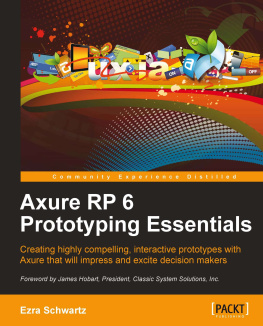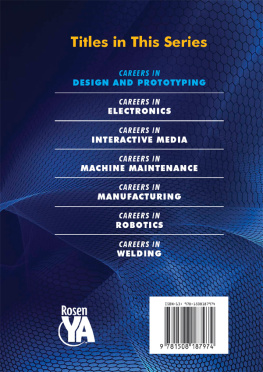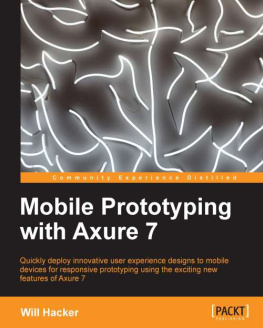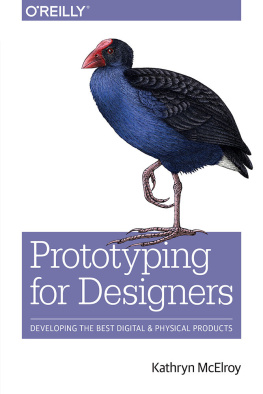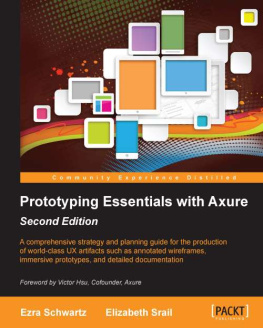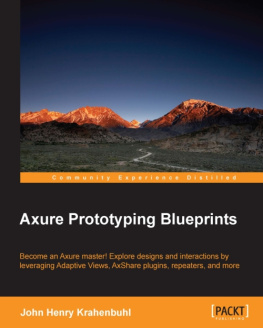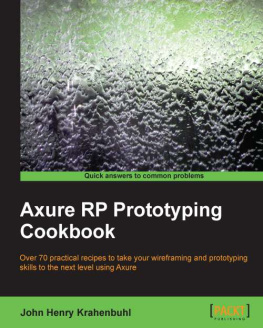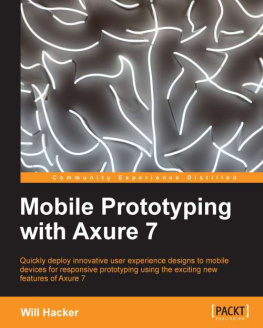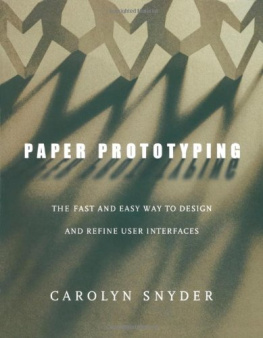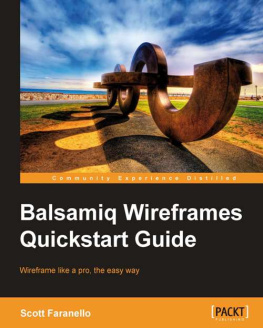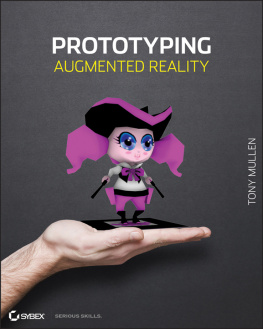Foreword
Axure is a powerful tool to transform abstract requirements into a working detailed visualization to support implementation and reduce project risks. We have experienced these benefits with many of our clients, allowing us to successfully lead enterprise design efforts with the worlds largest corporations. The lessons Ezra shares with you in this bookplanning what your specification will look like, and structuring masters to substantially reduce redundancy and rework, to name a fewwill help you unlock Axure's full potential and will save you significant amounts of work later in your project.
Here is a brief story about how Axure and the techniques in this book were used successfully on a recent enterprise project: We were engaged with a large Silicon Valley client to lead the User Experience effort for an enterprise Oracle implementation billed to "transform" the company's Quote to Cash internal systems. The big IT consulting players were on board with teams of business analysts, Oracle experts, and project managers. We began our efforts by heading out to the clients to conduct field research with the company's business partners and internal users. We followed this with a "Baseline" usability test of the existing system and concluded that an entirely new user interface was needed to truly transform the business. While conducting our research, the initial business requirements were starting to unfold, and we were sketching out user stories and task flows to understand the current business processes and areas for optimization. We then used Axure to visualize what the new system could look like.
Things were going along smoothly when an e-mail came in at 5 pm on Friday, requesting my presence at a brief executive meeting that same day. The execs were very happy with all the research we had accomplished and excited about seeing the future. In fact, we were informed that the executive sponsor would be having an annual meeting with the top 170 company leaders at an offsite resort in Carmel in 2 weeks and wanted to present a vision of what the transformation would look like. This was greattrue executive sponsorshiphowever it did not match with our project plan. The requirements were just being defined and we had barely cracked open Axure to begin wireframes. The executives asked me to show what we had designed so far. I summarily showed them a left sidebar menu and a blank screen.
They looked at me perplexed and said, "We don't see anything." "I know," I replied. "We have been completing our user research and are just finishing early sketches of potential designs. The vision you want to see was scheduled for six weeks from now."
That obviously was not going to meet the needs of our executive sponsor, so we quickly began creating a vision of the future in Axure. Loren Baxter (a contributor to this book) was evolving the prototype as fast as we could think of new ideas. He truly played Axure like a pianist at Carnegie Hall. Mastery of the tool (in this case, Axure) was critical to our ability to start from an empty slate and define a vision in days versus weeks or months. We met daily with execs and showed our builds as they evolved. This in turn accelerated the refinement of the requirements since the visualization clearly communicated the requirements as they were being discussed. The executive presentation was a resounding success and the entire company leadership became aligned with the new vision we created.
Moving from vision to a detailed set of wireframes and specifications was our next challenge. Ezra was brought on board to lead this effort and he applied the principles and strategies presented in this book. Our team of UX designers worked tirelessly during the next several months visualizing over 90 Business Requirements Documents, totaling over 1.5 million words. Many of the features in Axure 6 are a direct result of feedback we provided to the Axure team as we built our wireframes and detailed specifications. We used the naming strategies outlined in this book to keep us organized and to communicate to the larger project team as we ensured that our wireframes and specifications were in sync with the business requirements.
Once our UX wireframes and specifications were complete, we handed off our UX deliverables to the developers for implementation. By this time, the project team had grown to nearly 200 people working globally towards a very aggressive implementation date. All the work we had put into using Axure for detailed annotated wireframes, interaction models, and detailed specifications was leveraged to keep the project on track despite the usual changes in scope, IT implementation challenges, and changes in requirements.
The QA team used our wireframes to build test cases long before the development code was available. We continuously updated wireframes and specifications as changes to the requirements occurred and the naming conventions provided critical traceability between our wireframes and the business requirements. At the same time, we continuously used Axure prototypes to perform usability tests on areas of known concern to validate our design decisions as the project evolved.
Whether your project is a small effort for your department or a larger enterprise effort like the one I have described, the techniques and strategies in this book will help you successfully bridge the gap between abstract business requirements and what ultimately gets implemented by your development team. Axure can provide significant value to your organization while dramatically reducing project risks. I suggest you read this book in layers. First, master the great new techniques available in Axure 6 for creating rich visualizations. Then, apply the naming and architecture strategies and adapt them to your project needs.

